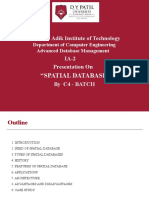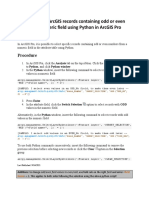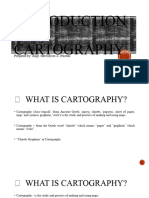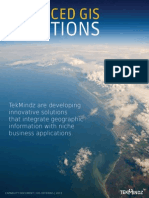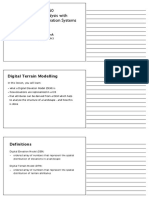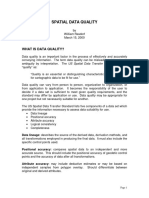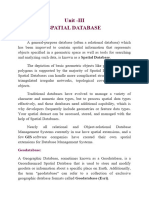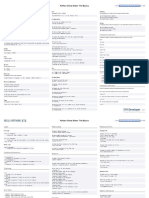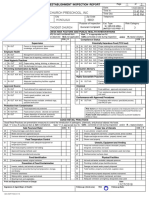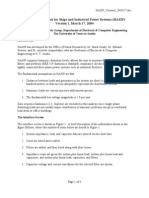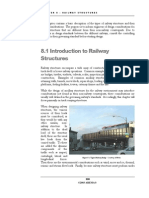Introduction to Spatial Database Management System
Presenter
James H.
Discussion Lead
Srujan K.
Paper author: Ralf Hartmut Guting Original slides by: Farnoush Banaei-Kashani
�Outline
Introduction Modeling Querying Data
& definition
structures and algorithms System architecture Conclusion and summary
�Introduction
Various
fields/applications require management of geometric, geographic or spatial data:
A geographic space: surface of the earth Man-made space: layout of VLSI design Astronomy space: the universe
Examples Examples
of non-spatial data: of Spatial data:
Names, phone numbers, email addresses of people NASA satellites imagery Rivers, Farms
�Introduction...
Non-spatial
query:
List the names of all bookstore with more than ten thousand titles
Spatial
query:
List the names of all bookstores with ten miles of Metrotown
�Introduction...
Common
challenge: dealing with large collections of relatively simple geometric objects Different from image and pictorial database systems:
Containing sets of objects in space rather than images or pictures of a space
�Definition
A
spatial database system:
Is a database system Offers spatial data types (SDTs) in its data model and query language Supports SDT in its implementation
�Modeling
Two
basic things need to be represented:
Objects in space: cities, forests, or rivers
modeling single objects
Space: every point in space (e.g., partition of a country into districts)
modeling spatially related collections of objects
�Modeling...
Fundamental
abstractions for modeling single objects:
Point: object represented only by its location in space, e.g., center of a state Line (actually a curve or ployline): representation of moving through or connections in space, e.g., road, river Region: representation of an extent in 2d-space, e.g., lake, city
�Modeling...
Instances
of spatially related collections of objects:
Partition: set of region objects that are required to be disjoint (adjacency or region objects with common boundaries), e.g., thematic maps Networks: embedded graph in plane consisting of set of points (vertices) and lines (edges) objects, e.g. highways, power supply lines, rivers
�Modeling...
A sample (ROSE) spatial type system
EXT={lines, regions}, GEO={points, lines, regions}
Spatial
predicates for topological relationships:
inside: geo x regions bool intersect, meets: ext1 x ext2 bool adjacent, encloses: regions x regions bool
Operations
returning atomic spatial data types:
intersection: lines x lines points intersection: regions x regions regions plus, minus: geo x geo geo contour: regions lines
�Modeling...
Spatial operators returning numbers dist: geo1 x geo2 real perimeter, area: regions real Spatial operations on set of objects sum: set(obj) x (objgeo) geo A spatial aggregate function, geometric
all attribute values,
area of the country
union of
e.g., union of set of provinces determine the
closest: set(obj) x (objgeo1) x geo2 set(obj) Determines within a set of objects those whose spatial attribute value has minimal distance from geometric query object
�Modeling...
Spatial relationships: Topological relationships: e.g., adjacent, inside, disjoint. Direction relationships: e.g., above, below, or north_of, sothwest_of, Metric relationships: e.g., distance Enumeration of all possible topological
relationships between two simple regions (no holes, connected):
Based on comparing two objects boundaries (A) and interiors (Ao), filter to create 6 valid topological relationships:
disjoint, in, touch, equal, cover, overlap
�Modeling...
DBMS
data model must be extended by SDTs at the level of atomic data types (such as integer, string), or better be open for user-defined types (OR-DBMS approach):
relation states (sname: STRING; area: REGION; spop: INTEGER) relation cities (cname: STRING; center: POINT; ext: REGION; cpop: INTEGER); relation rivers (rname: STRING; route: LINE)
�Discussion 1
Most
of the databases have some or the other aspect of location/spatiality. What examples can you think of where time is involved that you'd want the specialized support of spatial databases, and when would normal support be fine?
�Querying
Two
main issues:
1. Connecting the operations of a spatial algebra to the facilities of a DBMS query language. 2. Providing graphical presentation of spatial data (i.e., results of queries), and graphical input of SDT values used in queries.
�Querying...
Fundamental spatial algebra operations: Spatial selection: returning those objects satisfying a spatial predicate with the query object
All cities in Bavaria:
Bavaria.area
SELECT sname FROM cities c WHERE c.center inside SELECT * FROM rivers r WHERE r.route intersects Window SELECT cname FROM cities c WHERE dist(c.center,
Hagen.center) <100 and c.pop > 500k
All rivers intersecting a query window
All big cities no more than 100 Kms from Hagen
Spatial join: A join which compares any two joined objects based on a predicate on their spatial attribute values.
�Querying...
For each river pass through Bavaria, find all cities within less than 50 Kms.
SELECT r.rname, c.cname, length(intersection(r.route, c.area)) FROM rivers r, cities c WHERE r.route intersects Bavaria.area and dist(r.route,c.area) < 50 Km
Requirements for spatial querying:
Graphical I/O issue: how to determine Bavaria (input); or how to show intersection(route, Bavaria.area) or r.route (output) (results are usually a combination of several queries). Spatial data types Graphical display of query results Graphical combination (overlay) of several query results (start a new picture, add/remove layers, change order of layers) Display of context (e.g., show background such as a raster image (satellite image) or boundary of states) Facility to check the content of a display (which query contributed to the content)
�DBMS extensions required
Representations for spatial algebra data types Procedures for the atomic operations (e.g., overlap) Spatial index structures Access operations for spatial indices (e.g., insert) Filter and refine techniques Spatial join algorithms Cost functions for all operations (for query optimizer) Statistics for estimating selectivity of spatial selection
and join Extensions of optimizer to map queries into the specialized query processing method Spatial data types & operations within data definition and query language User interface extensions to handle graphical representation and input of SDT values
�Spatial Indexing...
To deal with spatial selection quickly and efficiently (as well as other operations such as spatial joins, ) It organizes space and the objects in it in some way so that only parts of the space and a subset of the objects need to be considered to answer query Two main approaches:
1. Dedicated spatial data structures (e.g., R-tree) 2. Spatial objects mapped to a 1-D space to utilize standard indexing techniques (e.g., B-tree)
�Spatial Indexing...
A
spatial index structure organizes points into buckets. Each bucket has an associated bucket region
For
point data structures, the regions are disjoint & partition space so that each point belongs into precisely one bucket. For rectangle data structures, bucket regions may overlap.
�Spatial Indexing...
One
dimensional embedding: z-order or bitinterleaving
Find a linear order for the cells of the grid while maintaining locality (i.e., cells close to each other in space are also close to each other in the linear order) Define this order recursively for a grid that is obtained by hierarchical subdivision of space
�Spatial join
Traditional
join methods such as hash join or sort/merge join are not applicable. Filtering cartesian product is expensive.
Central ideas: filter + refine use of spatial index structures
For each river pass through Bavaria, find all cities within less than 50 Kms. SELECT r.rname, c.cname, length(intersection(r.route, c.area)) FROM rivers r, cities c WHERE r.route intersects Bavaria.area and dist(r.route,c.area) < 50 Km
�Discussion 2
Time
and space are modes by which we think and not conditions in which -- Albert Einstein Within Einstein's view time and space are equivalent quantities, and time is only a fourth dimension where existence resides.
We
Yes, we can and we should. No, even if we technically can,
can possibly think about merging the concepts of temporal databases and spatial databases and have everything defined within the framework of spatial databases.
not.
we should
�System Architecture Revisited
The
only clean way to accommodate these extensions is an integrated architecture based on the use of an extensible DBMS. Hence, current commercial solutions are OR-DBMSs:
IBM DB2 (spatial extenders) Informix Universal Server (spatial datablade) Oracle 10g (spatial cartridges)
�Conclusion
SDBMS
is valuable to many important applications A spatial database system:
Is a database system which offers SDTs in its data model and query language and supports SDTs in its implementation, especially spatial indexing and spatial join
Objects
in space and space are two basic entities need to be modeled/represented Fundamental spatial algebra operations includes spatial selection, spatial join
�Contacts
James
H. (blackfridaywebcom(at)gmail.com) Black Friday Web - Best Deals and Smart Guys meet here: http://blackfridayweb.com


